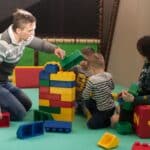Running an effective Little League practice is crucial for developing young players’ skills and love for the game. But a coach should know how to structure a great little league practice if they want to see the kids up for success.
Well-structured practices improve technique and keep kids engaged and excited about baseball or softball. However, as a Little League coach, volunteering your precious time and understanding how to structure a practice can feel like the ultimate task. Below, we’re talking about how to structure a great Little League practice so that everyone involved, parents, players, and coaches, reap the full benefits of this fun experience.

The Fundamentals of a Great Little League Practice
Breaking down a practice session into distinct phases—warm-ups, drills, and scrimmage time—provides a clear framework for both coaches and players. Warm-ups prepare the kids physically and mentally, which sets the tone for the session. Drills, designed to target specific skills, further enhance the players’ abilities. Scrimmage time allows kids to apply what they’ve learned in a game-like scenario and reinforces their skills in a fun, competitive environment.
Structuring Drills for Different Age Groups
Customizing drills for various age groups makes each practice age-appropriate and engaging. Younger players, typically under eight, benefit from drills that incorporate basic skills with lots of movement and fun. Activities like “sharks and minnows” improve agility and coordination while keeping kids entertained.
For older players, around 9 to 12 years old, more advanced drills that focus on technique and strategy are beneficial. Exercises like batting practice and fielding drills will challenge their growing skills. Always remember that helping players pick out the right bat can profoundly affect their performance and confidence at the plate, so it’s important to spend time in practice doing fittings and equipment checks.

The Role of Parents in Practice
Parental involvement in Little League practices can greatly enhance the experience for young athletes. Encouraging parents to participate in drills or assist with warm-ups strengthens the community and shows kids that their parents care about their activities. This support is incredibly motivating for young players. It’s also common for parents to assume coaching responsibilities since Little League coaches are volunteers, not paid professionals.
Parents can also reinforce skills learned during practice at home. Simple activities like playing catch or practicing batting in the backyard contribute to their child’s development. Parents must remember that positive reinforcement and enthusiasm can make a world of difference in their child’s growth and love for the sport.
Balancing Fun and Progress
Make sure practices are enjoyable while advancing skills to keep young players engaged and invested. Incorporate fun games that reinforce fundamental skills, such as relay races or a home run derby, to break up the monotony of repetitive drills. These activities make practice exciting and help players improve.
Structuring a Little League practice to be engaging, rewarding, and beneficial is difficult when you’re just starting out. Whether you’ve been coaching for years or just volunteering as a parent, take these tips along for the ride to make the most of the experience and learn how to structure a great little league practice. It’s as much about the kids learning as it is for the parents and coaches.






These sound like some awesome tips. My daughter briefly played softball and then got distracted by something else.
I’ll pass this on to my hubby so he can try incorporating some of these ideas into his team practices. I love the focus on keeping things fun and engaging for the kids!
Little Leagues can be such a great experience. It is good to focus on making the most out of practices.
This is so perfect and I’m going to share this post with my brother in law as he is going to be working with his son this coming year. I cannot wait to see him play and appreciate this informative post packed with tips that he can use 😉 Thank you!